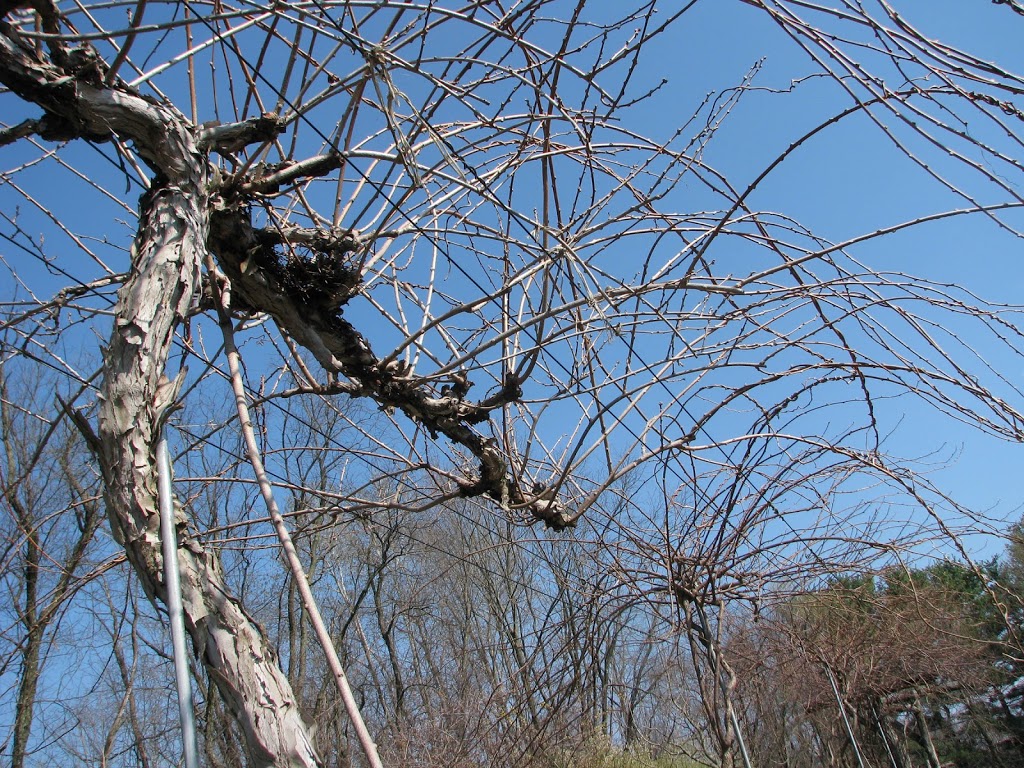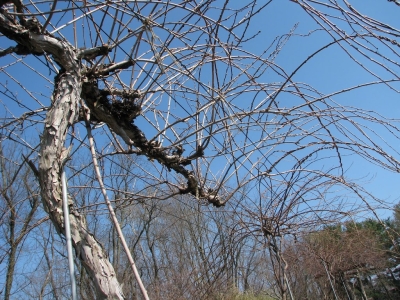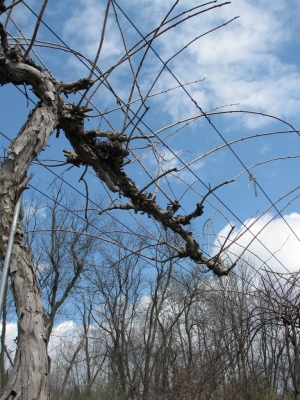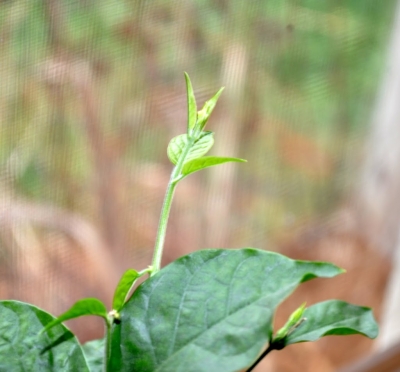A Jump on Spring
I got a jump on spring yesterday and started pruning hardy kiwifruit vines. The fruit is a kissing cousin of fuzzy, market kiwis, except, with smooth skins and small size, they can be popped whole in your mouth like grapes. Hardy kiwis are also cold-hardy, which their cousins are not.
The vines need yearly pruning to let light and air in among the stems for productivity and plant health, to keep fruiting stems within easy reach, and to stimulate new stem growth each year off which grow fruiting shoots the following year.
My plants are trained on 5 wires strung between T-trellises, one wire down the middle of the trellis flanked by 2 wires on either side of that central wire. Each plant’s trunk rises up to the middle wire and then divides into two cordons, or permanent arms, that run in opposite directions along the middle wire. Fruiting arms, which are 1-year-old stems, grow off perpendicularly to the cordon to drape down over the outside wires.
As I approached the vines with shears, lopper, and small saw in hand, the vines looked back at me like an intimidating, tangled mess. Three steps in pruning brought everything in order. I first cut back all fruiting arms to within a foot or so of the outside wire and shortened each cordon back to where it began growth last year. Arms bear fruiting shoots near their bases so don’t need the whole of their lanky stems. As to the cordons, if they were allowed to grow longer and longer, one plant would tangle into the next plant down the row.
Next, the hardest part: I reached into the remaining tangle to cut back fruiting arms that have, over the years, begun to originate further and further off the cordons. These got shortened so that new shoots, for fruit 2 years hence, would originate closer in to the cordons. Left to their own devices, as they are in the wild on the edges of Asian forests, the vines would be climbing 100 ft. high on anything on which they could grab hold.
Finally, I thinned out most of the remaining fruiting arms so that they are about a foot apart. I’ll do a final pruning in spring, thinning more where needed and shortening all fruiting arms to their final length of about 18 inches long.
I’m left now with a pile of prunings. Their intertwining stems make nice decoration. I could also save some for my cat. Kiwi stems have a pleasing effect on the cats, similar to catnip. In Asian zoos, they have been used to calm “large cats.”
————————————————-
What joy a mere sprout can foreshadow! Late last summer a gardening friend gave me some sprouts from her Maid of Orléans jasmine (Jasminum sambac). By the end of summer, a few of the cuttings had rooted and even flowered. The plant or its flower wouldn’t win (or lose) any beauty contests, but is well worth growing for its unabashed fragrance. The aroma is sweet and rich and not at all cloying, even after the flowers fade.
What’s more, this jasmine flowers freely. As a matter of fact, it just finished its second round of flowering. Contrast this behavior with my two plants of common jasmine (Jasminium officinale). These latter plants occasionally cough forth a few flowers in late winter but nothing like the profusion of white blossoms they once did. I’ve tried everything, from starting new plants from cuttings to pinching shoots all summer until August to keeping them cool in until late winter to keeping them dryish until late winter to keeping them cool and dryish until late winter to keeping them in the greenhouse to . . . you get the picture.
The only dark cloud hovering over my Maid of Orleans was the potting mix. Something seemed not quite right with it, having me worried that the plant might not grow or, worse, expire (as did the plant from the gardening friend from whom I got the cuttings). Not that this is a time of year to expect growth from any plant.
But now, that cloud has moved on. The new sprout looks happy and healthy and foretells of a fragrant future.
————————————————-
I mixed up a new batch of potting soil, which I’ll need anyway in a couple of months for indoor sowing of the first seeds of next season. Into a 5 gallon bucket went finished compost and soil, equal parts, sifted. Into another 5 gallon bucket went peat moss and perlite, equal parts, sifted. I tipped the contents of both buckets together into the garden cart, sprinkled on 1 cup of soybean meal and a handful of kelp, and repeatedly slid a flat-bladed shovel under the pile and turned it over and over. Once everything was thoroughly mixed, I shook and forced it again through the 1/2-inch sieve and packed it away into buckets.
This potting mix will be home to the roots of seedlings and houseplants, as well as large, potted fig trees, roses, and pomegranates. Also, to Maid of Orleans, as soon as she outgrows her present quarters.






